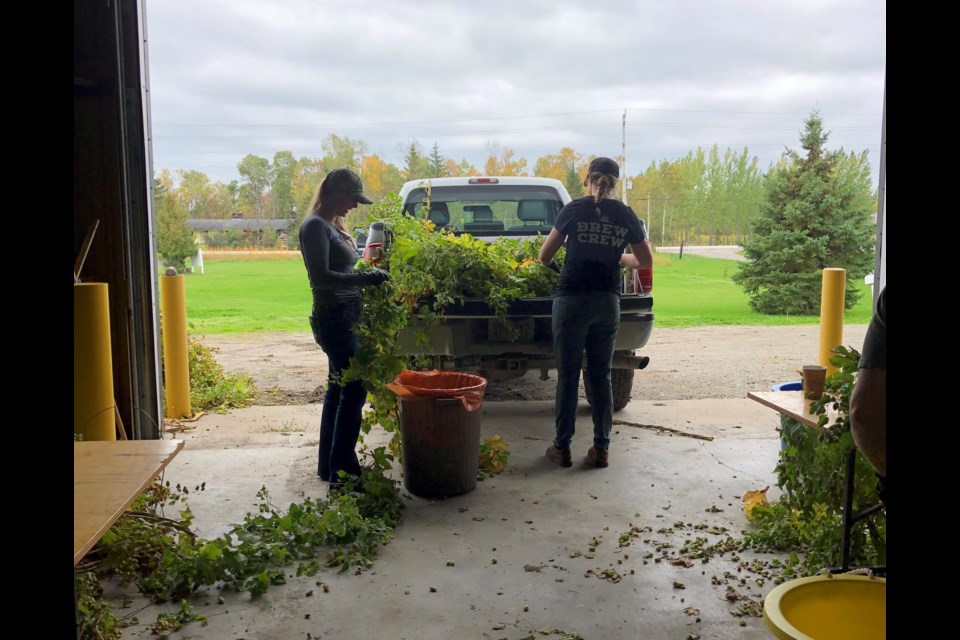Research technician Kim Jo Bliss jokes that once the Emo Agricultural Research Station starts producing its own beer, she will retire.
Lucky for her, that dream is not far off in the future.
The research centre, located in the Rainy River district of northwestern Ontario and affilitated with the University of Guelph, set out to prove the commercial potential of growing hops in the North two years ago.
This year, some of their crop was turned into a specialty wet brew by Lake of the Woods Brewing Company in Kenora.
After being approached by the Rainy River Future Development Corporation in Fort Frances, Bliss and her team of two summer students agreed to plant a hops yard on a small tract of land, between a quart and half an acre in size.
The purpose of the demonstration project was to explore the economics of growing hops in Northern Ontario, to explore the potential market for the product, and to encourage others to follow suit.
In a short time, they've already met their goals.
Want to read more stories about business in the North? Subscribe to our newsletter.
In partnership with the Ministry of Agriculture, Food and Rural Affairs (OMAFRA) and the Northern Ontario Farm Innovation Alliance, the research station planted half the allotted yard in 2017, and the other half in 2018.
Interest in the project was immediate, and a number of local partnerships have already grown.
“Lake of the Woods came down from Kenora with a group of people this past October, and we just picked as many hops as we could in the time that they allowed,” said Bliss.
“The amount we picked was probably around half a dozen big garbage bags full of hops. That equalled something like 1,800 litres of beer.”
As the craft beer market continues to grow in Northern Ontario, so does demand for locally grown crops, but as of now, there aren't many commercial producers in the region.
According to Brad Barta, assistant brewer at the Niagara College Teaching Brewery, there is an inherent risk in the hops supply chain in its current manifestation.
Many brewers in Ontario (and elsewhere in the world) source their hops from very specific locations in the U.S. If there is ever a bad harvest, like during the hops crisis of 2007 and 2008, than their supply chain is at risk.
Securing a supply contract for hops can also be a long process. Some brewers sign contracts one to three years in advance. When there is a hops surplus, brewers can purchase hops on the spot market – but during a shortage, prices on the spot market can skyrocket.
Barta also addressed the potential threat of international importers. If a country like China ever decides to start purchasing its hops overseas, he said, it will have adverse implications for North American brewers.
When Barta visited Sudbury in November for Cambrian College's inaugural Northern Ontario Craft Brewing and Distilling Summit, he encouraged local brewers to consider growing their own hops or sourcing it locally.
Growing hops in Northern Ontario is not something entirely new. According to Bliss, there are many people throughout the region that might grow a couple plants here and there for personal use.
Hops are primarily used as a bittering, flavouring, and stability agent in beer. It's a unique crop because a grower doesn't need 160 acres of land for an effective yield.
However, Bliss said, there are some challenges hops growers might consider.
“Weather is an issue, but that's an issue with all crops. There's a bit of work involved with the plant in the spring, and they also require a fair bit of water.”
Startup costs can also be high as growers need to invest in infrastructure such as hydro poles, cables, and irrigation systems.
Return on investment can also be slow – it could be five or six years until the plants reach their maximum potential.
OMAFRA has already done a fair bit of work researching commercial hops production in Ontario. The information is available on its website about growing the crop and its value.
Bliss and her team plan to continue exploring the economic viability of growing hops in Ontario. She and her students have particularly enjoyed working with the plant for the last couple of years.
It's a neat crop, and on a hot summer's day, Bliss said it's “nothing” for the plant to grow 12 inches. It's also quite beautiful to look at, and as a crawler, it grows quite tall.
Bliss enjoys people stopping by the research centre to talk about the crop and the work that they are doing. To anyone considering commercial production, she would tell them not to be afraid.
“It might be slow to get into the market, but the market is definitely there,” she said. “It's a cool little project that definitely has some real claws to it.”
